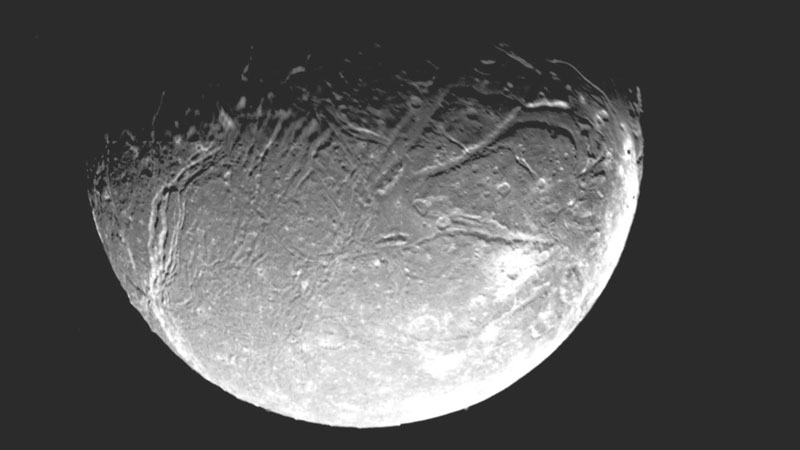In four billion years, humanity will have to seek salvation on the outskirts of the solar system from the Sun, which has shed its shell. This will be possible only if there are huge reserves of water there. There are hints of global oceans on many satellites of the giant planets – Jupiter and Saturn. But water may also be abundant on the moons of distant planets such as Uranus and Neptune, as recently revealed by data from the James Webb Telescope.

An artistic representation of Uranus and its moon, Ariel. Image source: NASA
Scientists from the Laboratory of Applied Physics named after. Johns Hopkins University (APL), led by planetary scientist Richard J. Cartwright, used the infrared spectrometer of the NIRSpec instrument at the Johns Hopkins Space Observatory. James Webb for chemical analysis of the substance on the surface of Ariel, one of the closest satellites of Uranus. This is the brightest satellite of this planet, a significant part of its surface is covered with ice. What kind of ice this is and how it forms has long been of interest to scientists.
The only partial image of Ariel was taken by NASA’s Voyager 2 probe on January 24, 1986. A mission to the Uranus (and Neptune) system would be a real gift to scientists, but it is not yet seriously planned. The Chinese may be up to something like this, but there is no exact data on this matter.
The ice on Ariel’s surface is unevenly distributed. Since the satellite always faces one side towards Uranus (it is tidally locked in relation to the planet), on the far side the ice layer is larger – up to 10 mm, and on the near side it is only 0.3 mm. Analysis showed that it is mainly frozen carbon dioxide. Webb’s data also revealed traces of carbon monoxide on Ariel and a number of other chemical compounds, including carbonates.
Seasonal changes on Ariel should have removed significant amounts of carbon dioxide from its surface, but for some reason this does not happen. Its volumes are replenished by some source or sources. Carbon dioxide can be replenished during chemical reactions in the presence of charged particles from the magnetosphere of Uranus (the so-called radiolysis process). However, its reserves can also be replenished by the subsurface global ocean.
The reverse side of Ariel is riddled with small and large cracks. Substances can either seep through them or be sprayed into aerosols around the satellite during cryovolcanic activity on this moon. Similar processes could explain why there is so much carbon dioxide ice on Ariel. The presence of carbonates also speaks in favor of a subsurface ocean – these salts are formed when rocks come into contact with water.

One of two images of Ariel taken by NASA’s Voyager 2 probe in 1986
Finally, the deposits of carbon monoxide (carbon monoxide) discovered on Ariel also cannot be explained by reasons other than its constant replenishment from the bowels of this moon. For this gas to cool and settle as a solid on the surface of Ariel, it is not cold enough. At least -18 °C is not enough for carbon monoxide to begin to accumulate there in the form of deposits. These are all indirect hints at a subglacial ocean on Ariel, but taken together, these data may give scientists the key to searching for oceans on exoplanets. In our system, water will also come in handy, especially so far from the Earth (and the Sun).